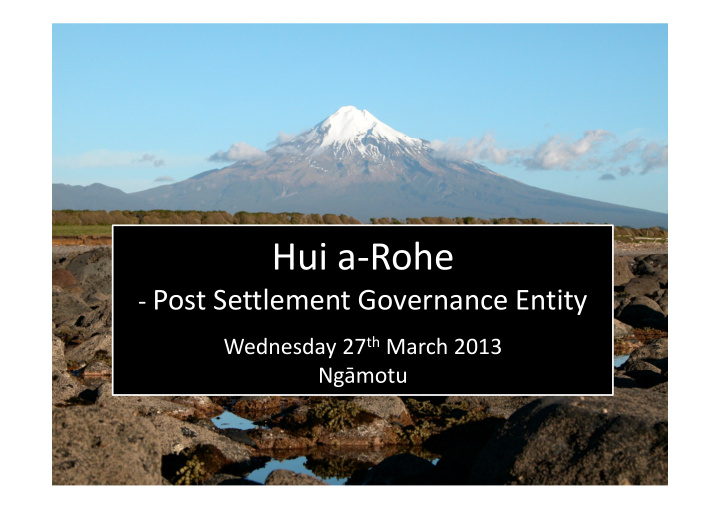



egoti Hui a-Rohe - Post Settlement Governance Entity Wednesday 27 th March 2013 Ngāmotu
Purpose of the Hui • To discuss the development of the Post Settlement Governance Entity • An opportunity for you to provide feedback and input into the development of the PSGE
Settlement Negotiations Progress R atification Recognition Agreement Draft Terms of and and Mandate in Deed of Legislation Deed Return Negotiation Principle Settlement of Assets Pre-Negotiations Negotiations Legislation Post-Settle
What is the process? • CLT developed “strawman” in 2012 to assess Crown offer • CLT and Trustees have discussed development of PSGE such as key features • Initial round of consultation Hui March 2013 – Receive feedback and input on key features via hui, email • CLT to develop consultation document on a proposed PSGE calling for further feedback • Feedback will be considered and a final proposal will be put to Nga Uri o Taranaki Iwi for ratification • If ratified Governance Entity will be established
What is a PSGE? • A Post Settlement Governance Entity (PSGE) is the legal entity a claimant group must ratify and establish before settlement with the Crown.
Why a PSGE? • A Post- Settlement Governance Entity (“PSGE”) for Taranaki Iwi is required to receive settlement assets. • The current Taranaki Iwi Trust is a Charitable entity and therefore unable to receive settlement assets on behalf of the iwi.
Structuring Overview • The choice of a PSGE legal structure is very limited • The Crown’s preference for a PSGE legal structure is a Private Trust • There are limited tax structuring choices – Transition issues with charities (and fisheries entities) – Significant value in designing optimal Group now
What should inform the structure? • A set of key principles • The future requirements – clarity about purpose, role and function • Should focus on group structure, not just PSGE – should be driven by your current and future needs, not by tax • Best structuring window – current and future needs vital – develop structuring needs now – get good advice
Considerations Affecting Structures • Acceptable for Crown Settlement purposes – adequately represents all members of the claimant group – is accountable to and ratified by the claimant group – has transparent decision-making and dispute resolution procedures. • Simple structures that are easy to understand and administer • Appropriate separation of risk for asset protection • Tax efficiency and tax reduction
Considerations Affecting Structures • Flexibility in making distributions (for example) – Sporting activities; – Beneficiaries outside of New Zealand – Superannuation – Political lobbying – Activities outside of New Zealand, international relations – Entertainment and recreation (festivals, children’s entertainment, music, performances); – Economic Development, environment and lifestyle of a region • More difficult to do the above if a charity
Considerations Affecting Structures The size of a PSGE and it’s associated functions and costs • Other variables will also impact on the functions of a PSGE and it’s • operating costs. Typical variables include: – The components of the settlement redress including quantum size. – The vision and priorities of Taranaki iwi including short and long-term goals. – The human capital within the iwi, including the capabilities and qualities of leaders of the PSGE – The existing relationships with key stakeholders such as central and local government agencies, the wider community, or neighbouring iwi. – The position of the existing governance entity in its lifecycle and how well prepared it is to manage and receive assets.
Considerations Affecting Structures • Corporate Trustee / Incorporation options – PSGE / Investment Trust / Development Trust • Governance – Smaller, cheaper and more efficient boards vs appropriate representation – Ensuring appropriate skills mix
Why establish a PSGE now? • Provides an opportunity to plan in advance of any potential settlement assets being returned • No guarantee that the settlement will proceed – this is a matter for nga uri o Taranaki iwi to determine through ratification • A focus and emphasis on post settlement is critical – a settlement in itself is not the end but rather a means to an end
Common Issues - Governance • Governance - Typical Issues – Establishing good governance practices – Commercial Board (representation, chair, external members) – Effective governance relationships (clear, effective policies) – Efficient subsidiary structures (e.g. entities, boards)
Common Issues - Management • Operations (Management) – Typical Issues – Establishing a robust policy framework – focus on core organisational activities (e.g. no policies for the sake of it) – Efficient and effective internal systems and processes – Board reporting, stakeholder reporting and management information – Shared services – Risk management and internal audit
Crown Requirements for PSGE • Adequately represents nga uri o Taranaki Iwi • Have transparent decision making procedures • Have transparent dispute resolution procedures • Be accountable to all uri of Taranaki Iwi • Ensure that those that benefit from the settlement are nga uri o Taranaki Iwi • Be ratified by nga uri o Taranaki Iwi
Taranaki Iwi PSGE Design Features • Representative • Accountable • Transparent • Viable/cost effective • Sustainable • Simple • Flexible • Tax efficient • Legislatively compliant • Contribute to the intergenerational aspirations of nga uri o Taranaki Iwi
Post Settlement Governance Entity • What does your PSGE do? – The PSGE.... • Why? – Because .... • Why? • Because.... • Why? – Because .... • So what are you passionate about?
Post Settlement Governance Entity • How do uri see themselves participating in the new post- settlement structure? • What role do you play? • How do you contribute to the future growth of Taranaki Iwi? • What is the preference for a structure for Taranaki Iwi PSGE? • Choose one from the following and explain your choice: – Hapu – Marae – Individual – Something else
Korero / Patai
Recommend
More recommend